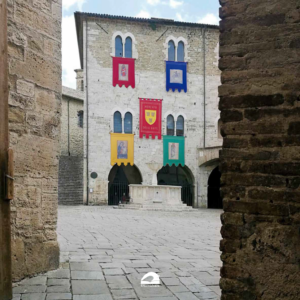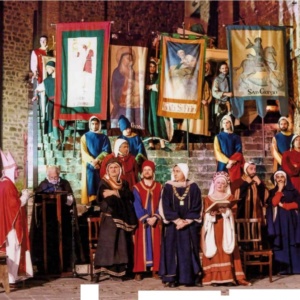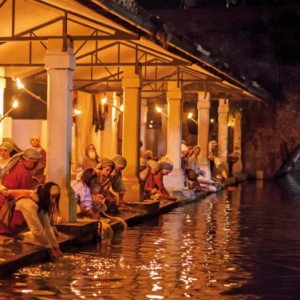The origins of the Mercato delle Gaite
From “Porchetta Festival”, begun in Bevagna in the early 1970s, by Associazione Pro Loco, the historical re-enactment of “Mercato delle Gaite” was born. The name Gaita derives from Waita, a Lombard term that indicated the division of the country into zones. Merit of Associazione Pro Loco was to enrich the festival with a medieval market starting from 1983, throwing the seed of the current event. Mercato delle Gaite Association was formally established on 26th April 1989 with the first statute, signed by the President of the Pro Loco, Angelo Falsacappa, who the would be elected the first Podestà of the Mercato delle Gaite following month.
The strong motivation leads to unexpected goals: conferences, vocational training courses are organized, the opening ceremony of the festival is held, which for many years sees the establishment of the Podestà, of the Consuls, the appointment of the Sovereigns, respecting the procedure set out in ancient statute of the Land of Bevagna dated back to the 16th century, but in large part formed by provisions dating back to the 14th century. The re-enactment covers the period between 1250 and 1350. The settlement of political magistracies and market days are recalled. With the reading of the announcement of the fair and with the opening of the doors of the town, merchants from every city of Italy came to the village, showing off their products, widely reported in the statute.
The Market, in the early years, started from Piazza Filippo Silvestri, branching off from the main artery to the alleys of the town, penetrating thus into the individual “Gaite”, where even today the artisans’ shops are opened, which, starting from the raw material, produce products that put up for sale.
Thanks to these activities, the Gaite people have enriched their knowledge. Reading the ancient texts, they succeeded in creating unique instruments, such as the human traction-twisting machine, the hydraulic multi-stack pile and many other ancient instruments, fundamental to obtain a faithful production. Moreover, people learned the ancient crafts and became leather makers, weavers. They begun to forge iron, mint coins, melt bells; they obtain sheets of paper from cotton wool, the Doplero from beeswax; they begun to blow glass; they knew the art of dyeing and apothecary, how to be a painter, a goldsmith, how to make and operate the stills, how to undermine and transcribe the ancient codes, work leather, obtain the parchment, use and recognize the herbs, from which they got the colors for dyeing, how to make silk, to work hemp. The Mercato delle Gaite has allowed a cultural raising of the country, which also engages with ancient recipes, recreating the tastes and settings in the revival of medieval dishes. The medieval banquet, for many years set up in the Cloister of San Domenico, today takes place in the main square, which with its elegant disharmony, provides a unique setting to welcome tall the guests. The dinners in the taverns are enlivened by medieval music, proposed by young and talented musicians from Bevagna, who, connoisseurs of medieval music, are appreciated in regional and national historical re-enactments.
The bow shooting is re-proposed, the only individual competition, which replaced the initial sling shot and involves and excites many young people from the area, who have also won great accolades in the national Arcatores circuit.
Mercato delle Gaite also has the merit of having transformed Bevagna from an agricultural town into a tourist center, bringing well-being, creating accommodation activities, making the village known beyond regional and national borders and encouraging educational tourism, which brings young people throughout the year to visit medieval crafts.

The four Gaite
![]() San Giorgio
San Giorgio
San Giorgio Gaita has a rather large surface but its territory includes large monastic factories, which affects the number of its inhabitants, making it a sparsely populated gaita. The territory develops from Porta Foligno to Piazza Silvestri, divided by San Giovanni Gaita from Via Flaminia, now Corso Matteotti. San Giorgio Gaita takes its name from the ancient oratory dedicated to San Giorgio, then donated by the Municipality, together with ancient Roman structures, to the Dominican Giacomo Bianconi who had the church and convent dedicated to San Domenico built there. Among the arty crafts made by San Giorgio Gaita, there are the processing of hemp, the mint and the art workshop of the painter.
![]() San Giovanni
San Giovanni
San Giovanni Gaita is distinguished by a very large and populated territory, being the center of ancient Umbrian-Roman Mevania. This Gaita takes its name from the oratory dedicated to San Giovanni, then donated to a community of Franciscan minors who built the church and convent, later dedicated to St. Francis. This Gaita develops from Porta Cannara to Piazza Filippo Silvestri. Amongst the ancient activities, there is the “valchiera”, the paper mill that produces “bambagina” paper, but also glass processing and bells and the oven for the bread.
![]() Santa Maria
Santa Maria
The Gaita Santa Maria takes its name from the small church, one of the oldest in the town, Santa Maria Filiorum Comitis, which was built by Count Rainaldo, feudal lord of Bevagna (news since 1198). The territory of this Gaita goes from piazza Filippo Silvestri to the door of Sant’Agostino. Santa Maria has specialized in the techniques of fabric processing, i.e. hemp and silk, among the traditional and more documented crafts of medieval Bevagna, but the masters of the timber and the inn have also been proposed several times.
![]() San Pietro
San Pietro
The center of the Gaita San Pietro is Piazza San Filippo, with the church of the same name, but the church from which it takes its name, San Pietro, documented until the 15th century no longer exists. It was most likely near the Church of Sant’Agostino. The territory of the Gaita goes from the square to the door of Sant ‘Agostino, divided from the Gaita Santa Maria by Via Flaminia, now called Corso Amendola.
Among the arty crafts of this Gaita, there are the apothecary and beeswax processing, but also the dyer, the scriptorium, the artistic stained-glass windows are proposed.
The festival and the competitions
In the last 10 days of June Bevagna returns to be the city that was between 1250 and 1350, a century rich in events, destruction and reconstruction, starting from the work of the Dominican Giacomo Bianconi. This is the time that Mercato delle Gaite recalls, with its joys and its sorrows, with its arts, professions, saints, nobles, people, tastes and sounds, proposing reconstructions of great suggestion and remarkable scenic quality. However, this festival is above all a competition between the four Gaite, who challenge each other in four different games: the Crafts, the Kitchen, the Market, and the Archery. The first three games perform on different days and are judged by different juries of experts, coming from Italian universities and from other countries. Each competition

takes place in contexts set up philologically with veritable pictures.
The first one is the scripted reconstruction of two arty crafts each Gaita, with a story that wraps the entire production process, from the raw material to the finished product. The second one, focused on the food of that time, studied from ancient recipes, proposes a convivial environment with the service. The third one is a market day, with the multiform society that revolves around it. Each competition will have its winner, but it is unknown until the last night of the festival. The overall score achieved by each Gaita in the three competitions will be add to the result of the Archery, usually organized in the great Piazza Filippo Silvestri as the final moment of the 10 days.
The victory is decreed only at the end of this last intense day, when the Consuls of the four Gaite, the Podestà, the Mayor, the Deputy Mayor, the verbalizing Secretary and the representatives of the police, after opening the envelopes containing the judgments expressed by the jurors, will read and count the points awarded for each race to each Gaita. Only then will it be possible to assign the coveted Palio, for which there is so much passion, so much joy and so much effort.
Gaite all year round: The Circuit of Medieval Crafts
One of the most important and lasting effects of the creative and organizational effort of the Bevagna re-enactors is the Cultural Circuit of Medieval Crafts: a permanent laboratory composed of four philological reconstructions within suggestive spaces and atmospheres, where Gaite artisans, by now experts of their own art, present the story with an engaging story, showing the entire production process. Workshops are also organized, which allow, especially the children, but not only, to experiment directly with the ancient activities, materials, methods, up to producing an artifact they can take away. The circuit, which attracts many visitors, especially young people and many schools, is open during all the festive moments of the year and, by reservation, at any time.
The four workshops are the Paper mill, the Beeswax shop, the Silk factory and the Plaboratory.
The Paper mill is where ‘cotton’ paper is produced. It is made with pulp derived from rags. The selection, the maceration and the pulp reduction of the fabrics thanks to the hydraulic multi-ply water-driven pile, the drying, the necking and the final calendering are the work phases that allow the production of the paper sheet.
The Beeswax shop is the ancient laboratory where candles in pure beeswax are produced: the wax is dissolved in copper boilers and then poured onto hemp wicks. Slowly the candle takes shape and through a skillful twist the so-called ‘duplero’ is obtained, a singular artifact characterized by a double flame and double duration.
The Silk shop shows all the various phases of silk processing (Ars sete): from the breeding of the silkworm up to the weaving of its precious thread on ancient looms, passing through the stages of reeling, that is the extraction of the thread from the cocoon and the twisting through a large circular human-traction twisting machine.
The Painter shop shows the artists at work in their laboratory. Through their gestures, it is possible to learn how colors, boards and binders are prepared, the phases of tempera on board are experimented and the secrets of medieval art are revealed.
Notoriety of the event
Known as the City of the Mercato delle Gaite, Bevagna has linked its name for years to this event, appreciated in Italy and abroad to the point that the Gaite can be considered as an “excellence” of the territory.
Over the years the historical re-enactment has gained the attention of not only regional media: magazines such as Medioevo, Rievocare, Medieval Histoire, Bell’Italia, Plein Air, Travel, Art and style, and programs such as Geo, De gustibus, Ulisse, Costume and società, Effetto Sabato, Sì Viaggiare, Kilimangiaro, as well as regional and national News, have widely dealt with it. In 2012, Mercato delle Gaite was immortalized in the photographs by the great photographer Steve McCurry, which were then included in the “Sensational Umbria” exhibition. In 2018, the event received the award of the National Association of Doc Italy, a recognition that is attributed to Italian excellence in the various fields of activity. Mercato delle Gaite has been and continues to be a very powerful communication and promotion tool. Before the birth of the event there was only one property owner in Bevagna and even at the end of the 1980s there were just 40 beds, mostly located in a religious structure. Today there are 2 hotels; 31 accomodations among which there are property owners, residences and bed and breakfasts, country houses, holiday houses and apartments, hostels and old residences; 27 farmhouses for around 1,100 beds. In 2018, the number of tourists hosted in the accommodation of the municipal area was almost 16,000 for 48,000 nights spent in Bevagna, with peaks recorded during the ten days of

Mercato delle Gaite. Therefore, the numbers show that Bevagna has gradually transformed itself from a place of passage into a destination for travel and accommodation. The Municipality of Bevagna, aware of the importance of historical re-enactment, has always been committed to support the development and qualitative improvement of Mercato delle Gaite and other important initiatives that the event has generated over the years. At a regional level, the festival is widely known and so much appreciated that it has become a qualified and essential reference point for other historical re-enactments. The presence of Bevagna is now stable at the Festival of the Middle Ages in Gubbio, which finds in Mercato delle Gaite the practical and experiential interface of the studies and theoretical research that the Festival promotes. Mercato delle Gaite is of great interest also by national networks. From this year Bevagna was the protagonist of the Festival of Medieval Places created in Pistoia to create an interregional itinerary that links all the medieval cities of Italy, surpassing the regional dimension, with a common calendar of historical events in 18 excellent medieval places on the national territory. Mercato delle Gaite is made possible by the commitment of the volunteers, the Gaite people. It is organized by Associazione Mercato delle Gaite, chaired by Podestà of the Gaite, Claudio Cecconi, assisted by the head of the secretariat, Alessandra Sideri, the Executive Committee and the scientific representative of the party, Franco Franceschi, professor of Medieval History at the University of Siena.
Each Gaita is governed by a Consul and by the councilors who form the Board.
The Major Council is formed, in addition to the Podestà, by the Consuls Federico Fondacci (Gaita San Giorgio), Angelo Palini (Gaita San Giovanni), Alfredo Assunti (Gaita Santa Maria), Roberto Crisanti (Gaita San Pietro), by the Mayor of Bevagna, Annarita Falsacappa and the Councilor for culture Rita Galardini.
PER MAGGIORI INFORMAZIONI


